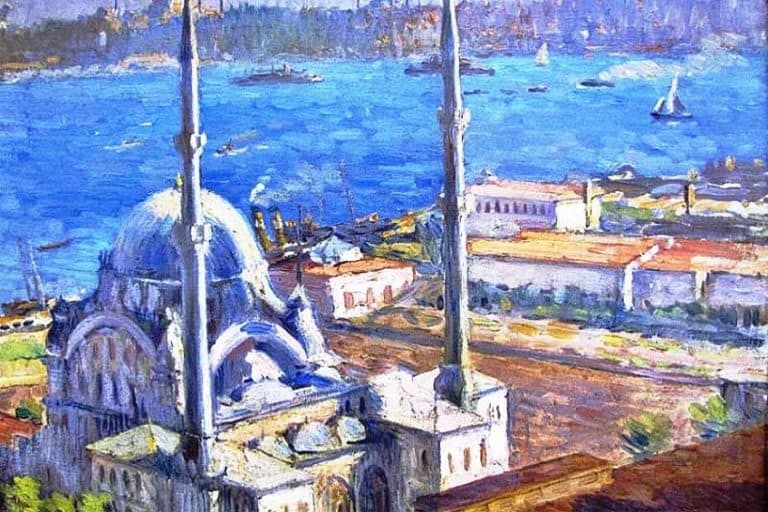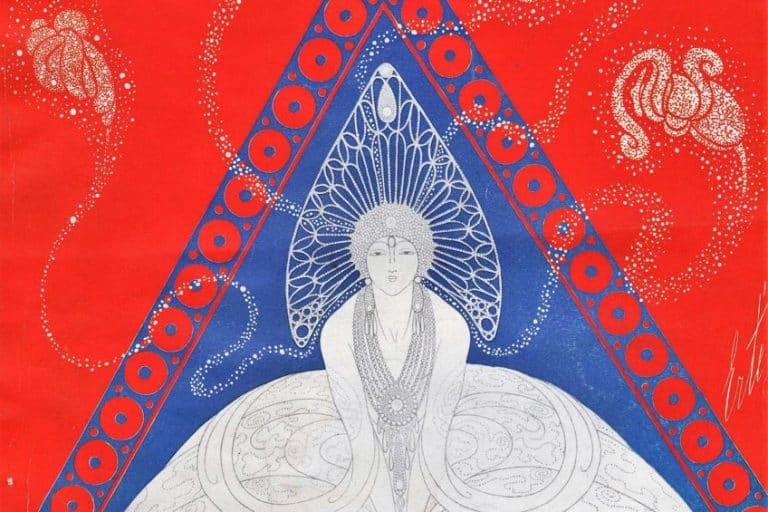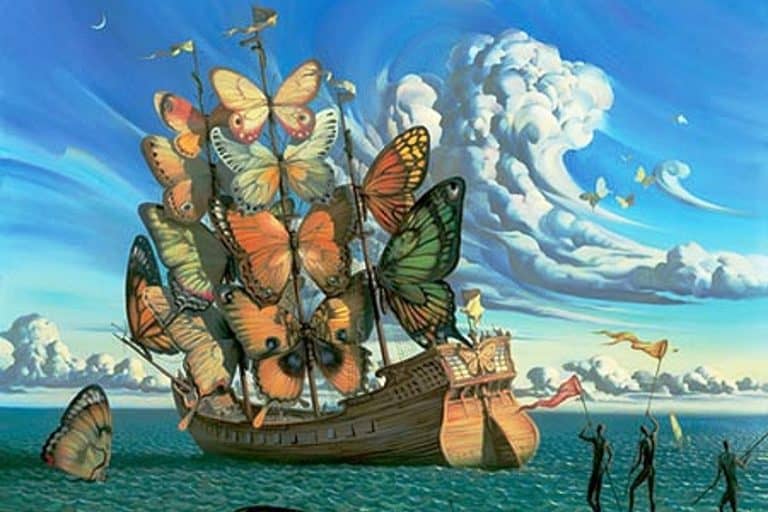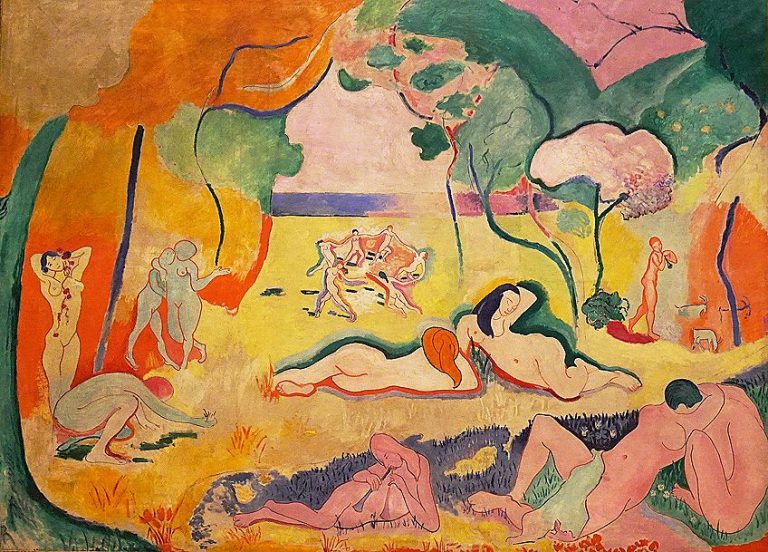Pieter Bruegel the Elder – The Northern Renaissance Artist, Bruegel
Pieter Bruegel the Elder was a Dutch artist whose life spanned from c. 1525 and 1530 to 1569. Although his life was short, the impact he made upon the art world was great. He broke the Renaissance mold and chose to focus on landscape painting, whilst his artistic peers stuck to Classical subject matter. His works were a huge inspiration for many artists of the Dutch Golden Age.
Artist in Context: Who Is Pieter Bruegel the Elder?
So, who is Pieter Bruegel? In this portion of the article, we will discuss Pieter Bruegel’s biography in order to give the reader an understanding of who he was. In later sections, we will go into more detail about his art specifically.
| Date of Birth | c. 1525 – 1530 |
| Date of Death | 1569 |
| Country of Birth | Netherlands |
| Art Movements | Dutch and Flemish Renaissance |
| Genre/ Style | Landscape painting |
| Mediums Used | Drawing, Painting, Printmaking |
| Dominant Themes | Landscapes, Genre painting |
Birth and Early Life
Unfortunately, we have only a vague understanding of Pieter Bruegel’s biography. The exact date of his birth is unknown; however, it has been estimated that he was born sometime between the years 1525 and 1530. His birthplace is another uncertainty. It is most likely that he was born in the city of Breda in the Netherlands.
On the contrary, some believe he came from a small village called “Brueghel” close to Breda. However, there are no records of such a place, so it is improbable.
Once again, Bruegel’s upbringing is also up for debate as nothing is known about his family. Many believe his parents were subsistence farmers like the majority of the European population at this time. This theory is further solidified by the prominent theme of the peasantry in Bruegel’s artworks.
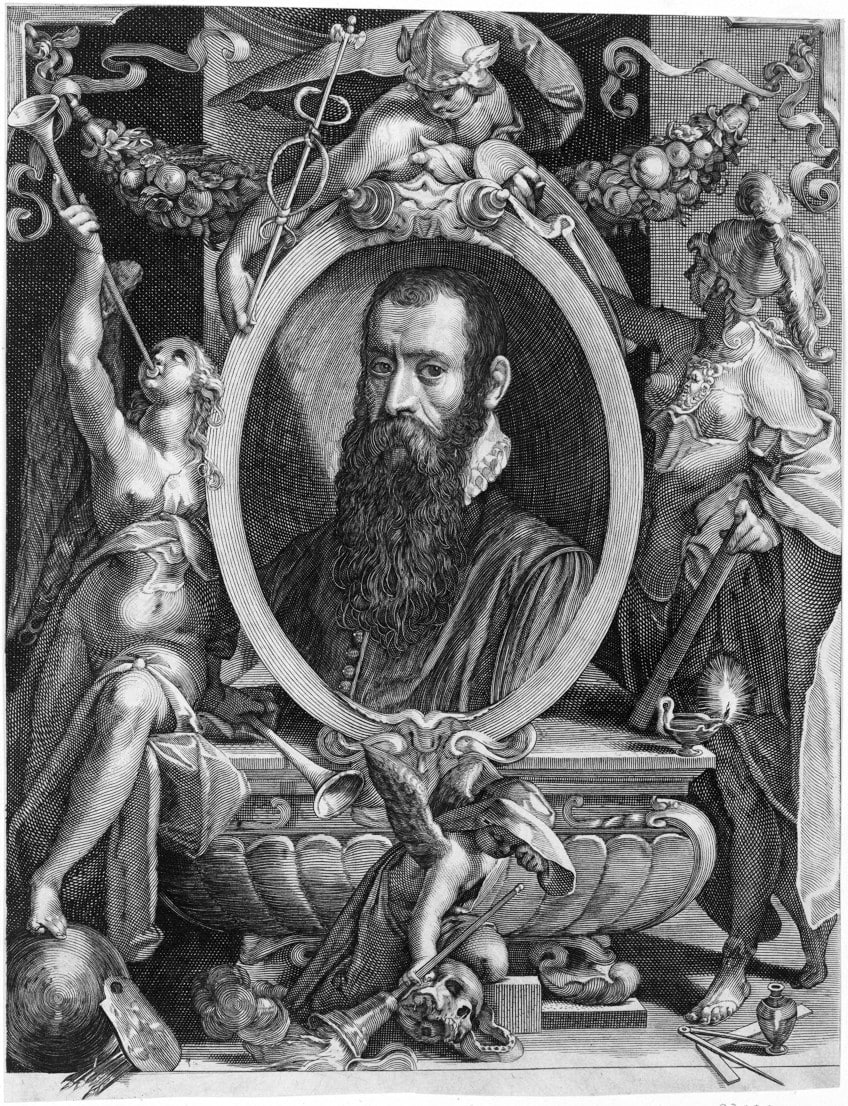
However, many disagree with the idea that Bruegel was brought up in a lower-class farming home. This is due to the highbrow nature of many of his paintings, which suggests that he was well-educated. The city of Breda was also where the Dutch Monarchy and many other aristocrats lived, making it plausible that Bruegel came from a wealthy family.
Those who advocate for his peasant background argue that as he was friends with many known humanists his education could have come from interacting with them. They back up this claim with the fact that Bruegel could not speak or write in Latin. Something he would have been taught had he been of higher social standing.
As Bruegel was born hundreds of years ago, when records were not kept like they are today. We will never be certain of his early life. Luckily, we know a great deal more about his later life and his career as an artist.
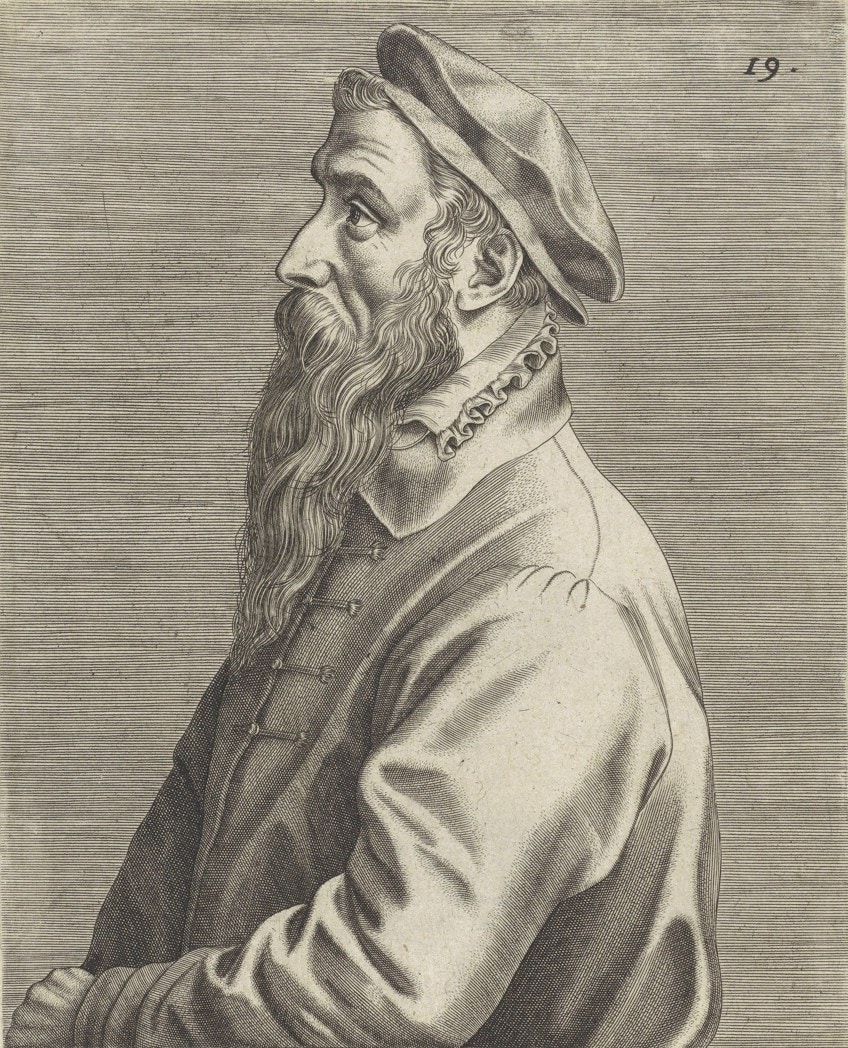
Education and Career
Thanks to records that were kept by the Guild of St Luke we know that Bruegel moved to Antwerp in 1551. Here he joined the famous painter’s guild, where he was mentored by the Flemish artist Pieter Coecke van Aelst. Bruegel studied under Coecke van Aelst for five years before the death of the latter. The two artists had a good relationship and Coecke van Aelst and his wife helped Bruegel become connected in the Flemish art scene.
After Coecke van Aelst’s death, Bruegel was offered to take his place as a master in the guild. He took this offer, but only for a short while before he decided to go traveling to Italy. During his time in Italy, he explored it from top to bottom before settling in Rome for a while. Whilst there, he met and collaborated with a number of other famous artists.
Interestingly, during his time in Italy, Bruegel sketched and painted the landscape exclusively. This was unusual as most artists who traveled there did so mainly for the old Roman ruins and Classical architecture.
Printmaking
In 1555, Bruegel returned to Antwerp where he began working for the influential printing company Hieronymus Cock. Bruegel did not actually work as part of the printing process, but rather prints and engravings were created from his original designs. His first project with the company was a 12-part series of prints called The Large Landscape series (1555 – 1556). These were a major success and Bruegel would go on to create 40 famous designs for Hieronymus Cock.

The original spelling of Bruegel’s surname was “Brueghel”. However, in 1559 he stopped signing his works “Brueghel” and opted instead for “Bruegel”. It is believed that he did this in an attempt to make his surname more Latin-sounding. This choice was likely due to the Classical influence of his humanist friends. He was the only member of his family to use this alternative spelling and even his sons used the original “Brueghel”.
As he changed the spelling before he became famous for painting, “Bruegel” is the spelling most commonly used when referring to the artist.

Painting
Bruegel only really began painting during the last few years of his life. However, he gained a great deal of success in this short amount of time. He was never want for anything and had a constant flow of commissions. Many of these were from the Flemish aristocracy and even the chief minister of the House of Habsburg ordered a painting from him.
His paintings were very unique for that period in time. With the High Renaissance movement dominating the art world, the Classical themes of Greek and Roman mythology were commonplace. Artists such as Michelangelo, Donatello, and Leonardo da Vinci were at their peak. However, Bruegel rejected the typical Classical and Biblical in favor of more rural scenes.
Many believe that Bruegel was inspired by the drolleries of the Middle Ages. Drolleries were little pictures used to decorate the marginals of important scrolls, typically those containing scripture.
Common themes for these drolleries were serene landscapes and peasants working in the fields. Bruegel took these themes and based whole paintings on them. This was very unusual for the time as landscapes were thought of as lowly art. Bruegel is credited with being one of the founders of genre painting due to his elevation of themes of the peasantry.
Marriage and Children
In 1563, Bruegel married Mayken Coecke van Aelst, the daughter of his former teacher. He had remained in contact with the family after the death of his master. Bruegel and Mayken’s relationship was one that many disapproved of. This was mainly due to the large age gap between the two. Mayken had only just turned 18, whilst Bruegel at this time was in his mid- to late thirties.
Mayken’s mother agreed to the marriage on one condition: The couple must move the Brussels. Her reasoning for this was due to rumors that Bruegel had been engaging in a salacious relationship with one of his maids. The couple agreed to this condition in order to go ahead with their marriage.
Although Antwerp was the art capital of Belgium, living in Brussels did not seem to hinder Bruegel’s career.
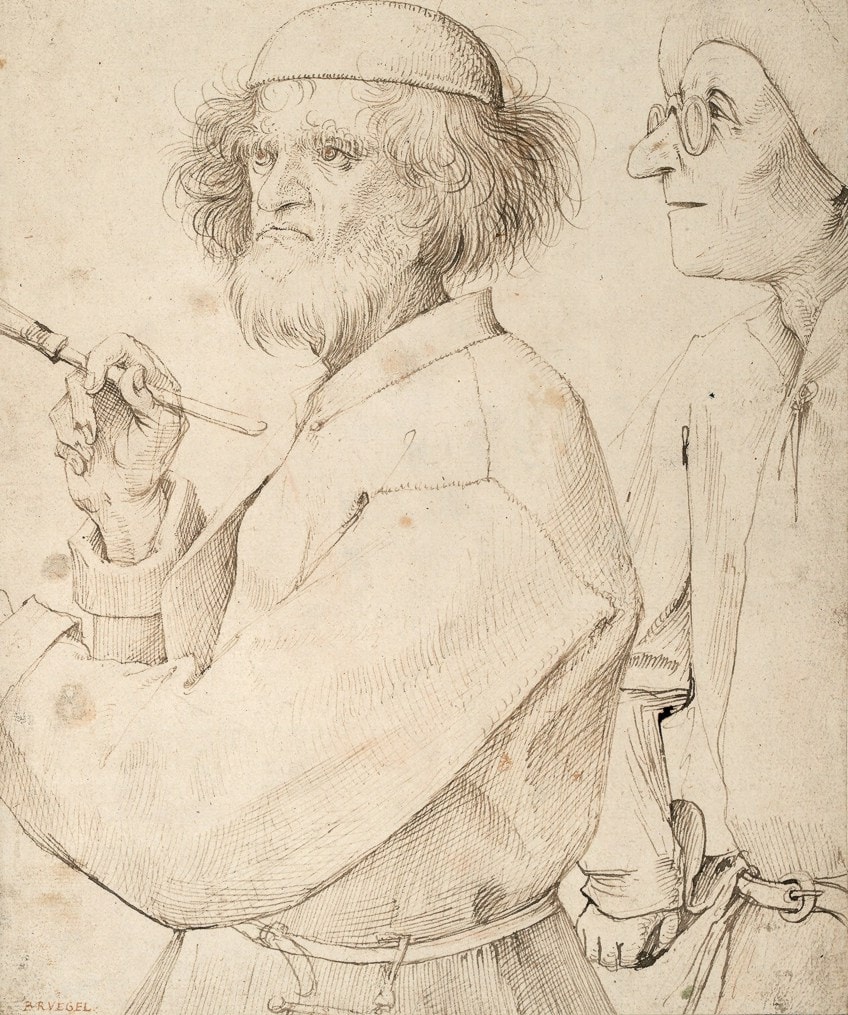
Bruegel and his wife were blessed with three children, a daughter, and two sons. Their daughter did not pursue a career in art and so very little is known about her. However, his sons Pieter Brueghel the Younger (hence why he came to be known as Pieter Bruegel the Elder) and Jan Brueghel the Elder were each successful artists in their own rights.
Final Years
The cause of Bruegel’s death in September 1569 is not certain. His life was considered to be short even for that period in time. There are two reasons that lead historians to believe that he died of an illness from which he had suffered for a prolonged period of time. Firstly, he was not conscripted for the Eight Year’s War, which started two years before his passing. This indicates that he was already sickly during this time.
The second reason is that he created no paintings during his final year, which once again indicates that he was too ill to do so.
Artistic Characteristics of Pieter Bruegel the Elder
The paintings of Pieter Bruegel the Elder are very distinctive. He explored a few key themes in the majority of his works. He also had a somewhat formulaic way in which he composed his painting. These common characteristics as well as the techniques and color schemes he used will each be examined.

Themes
Bruegel often produced paintings, which included key similarities. One such similarity was that he had certain themes, which he enjoyed and thus often replicated. These themes, such as peasant folk, symbolism, and satire will be evaluated below.
Landscapes and Peasantry
There are two overarching themes, which can be found in almost every one of Bruegel’s paintings. These are the peasantry and working class as well as landscapes, which are often the focal point of the painting. Both of these features were very uncommon subjects for paintings in Bruegel’s day. Typical themes included biblical allegories and epic Classical depictions.
Although Bruegel created one or two paintings of this nature, they were subjects he tended to avoid.
Due to his frequent portrayal of peasants going about their daily routine Bruegel is credited with playing a formative role in the creation of genre painting. Genre painting, sometimes known as petit genre, became very popular during the 1800s. Although Bruegel’s artworks were about 300 years ahead of their time they were still appreciated by art lovers of his time.

Satire
Bruegel was an artist who did not take himself all too seriously. It was typical of him to include witticisms and humorous imagery in his paintings. This was also a common characteristic of many Northern Renaissance artists. Satire is evident in some of his most famous paintings such as Landscape with the Fall of Icarus (c. 1558) and The Fight Between Carnival and Lent (1559).
The Landscape with the Fall of Icarus recounts the Greek tale of Icarus. Icarus dreamed of flying like a bird, so he fabricated his own wings by covering himself in wax and feathers. This allowed him to soar through the heavens. His father warned him to practice caution and not fly too close to the sun. He did not head this warning and the wax melted from the sun’s heat, causing him to plummet to earth.
Bruegel portrays this through a comical splash and flailing legs in the sea of his landscape.
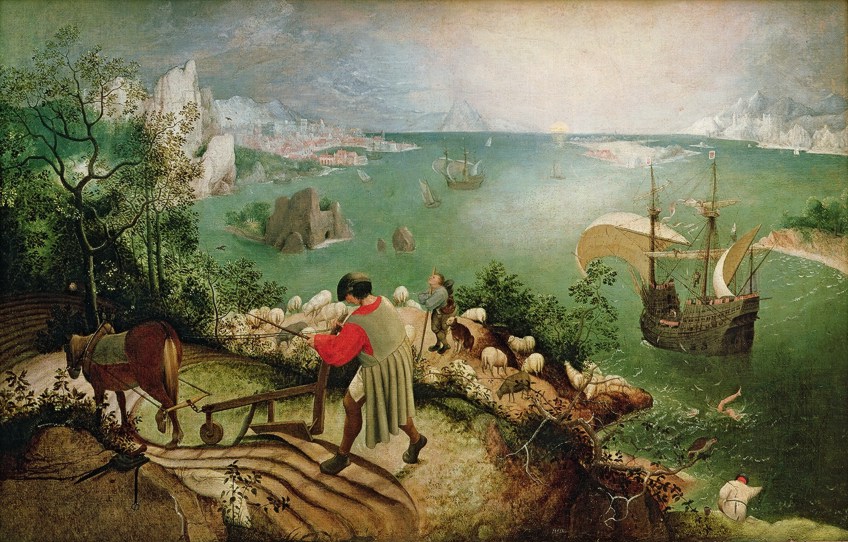
The Dutch Proverbs (1559), also known as The Topsy Turvy World, is another humorous painting of Bruegel’s. It is an anarchic painting containing almost 120 personifications of traditional Dutch proverbs. One can see a woman tying a demonic creature to a pillow, which illustrates the Dutch proverb of “even being able to tie the devil to a pillow”, meaning to be persistent. On the roof of the building, we see circular objects, which portrays the proverb “to have the roof tiled with tarts”, meaning to have a lot of money.
The whole painting is bizarre and hilarious.
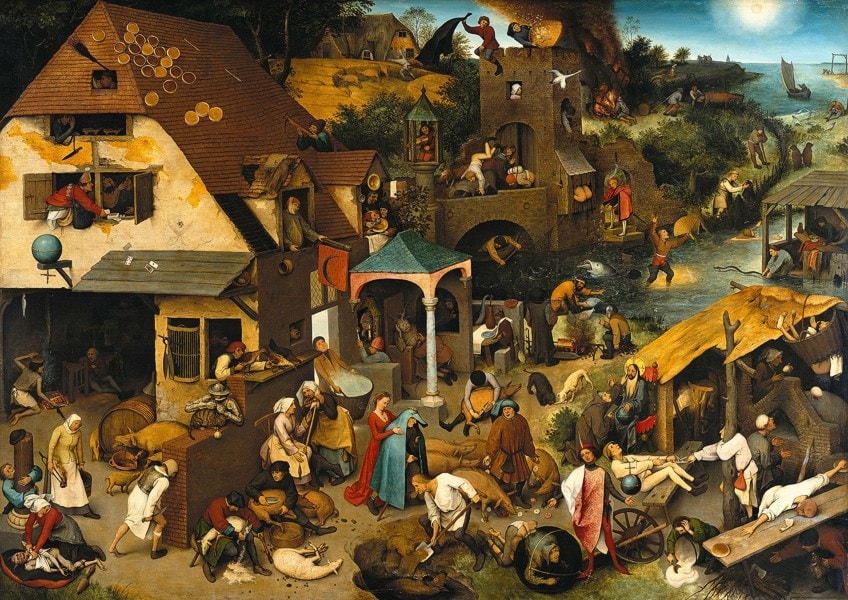
Symbolism
The Fight Between Carnival and Lent is full of various layers of symbolism. It juxtaposes the holidays of Carnival, which is all about opulence and pleasure with Lent, which is a time of sacrifice and piety. He does this by contrasting churches with taverns, nuns with noisy street vendors, and brightly dressed party-goers with dark cloaked figures.
The painting is believed to be a commentary on the battle between the staunch Catholics and the modern Protestants, which eventually resulted in the Spanish Inquisition as well as the Eight Years’ War.
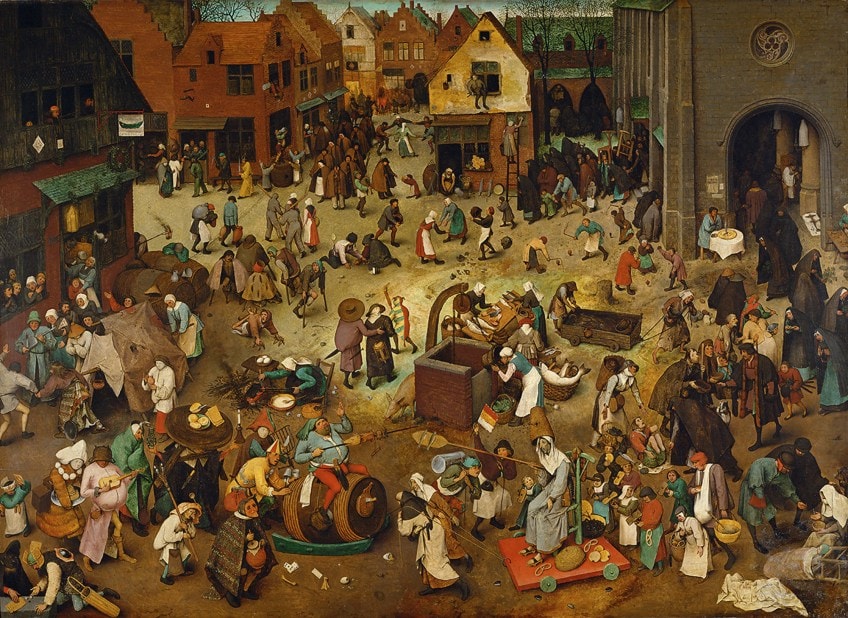
The Tower of Babel (1563) is another one of Bruegel’s paintings, which subtly comments on the state of Europe during the time. He uses the biblical story of the Tower of Babel to convey his message. In the story, the king tries to build a tower that will reach God. In order to prevent this, God causes the builders of the tower each to speak a different language so that they cannot speak to one another.
Bruegel uses the allegory to symbolize the divergence between the Catholics and the Protestants. Although they are all Christians, they are no longer one homogenous group.
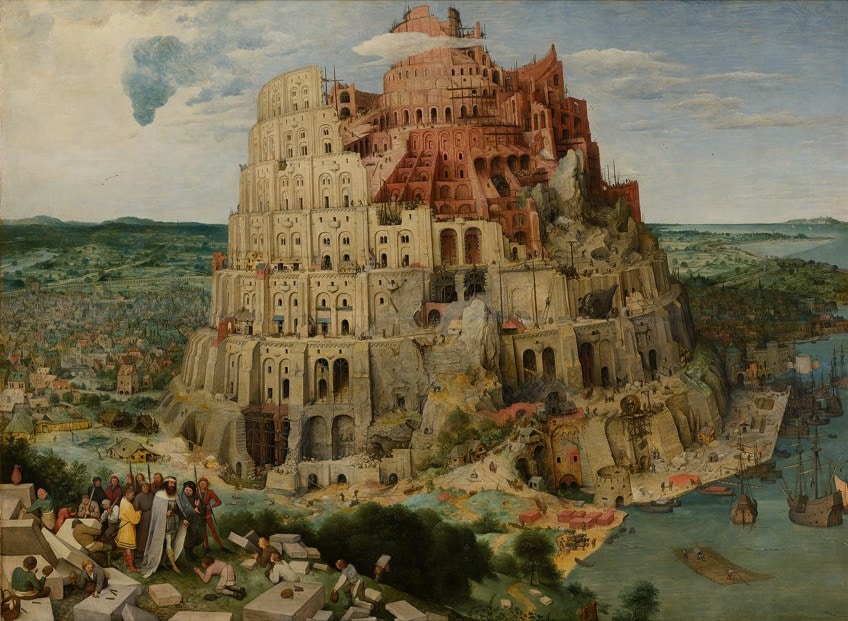
Color and Composition
Just as Bruegel had key themes he used frequently, he also has prevalent color schemes and ways of organizing his paintings. In terms of composition, he was fairly traditional. So, what Northern Renaissance characteristics did Pieter Bruegel the Elder incorporate in his paintings? Many artists of the Northern Renaissance, such as Hieronymus Bosch created chaotic, intricately detailed paintings.
Bruegel was no exception. He also liked to divide his background and foreground at a diagonal as it is more interesting to the eye.
When it came to color, Bruegel was a chameleon, adapting his palette to whatever was needed for the painting. Typically, he enjoyed bright color combinations of reds, blues, and greens like in The Wedding Dance (1566). However, in paintings such as Hunters in the Snow, he uses a simple palette of white and icy green to indicate the coldness of European winters. The figures in this painting are also dark and dreary to show that winter can be a grim time in that climate.
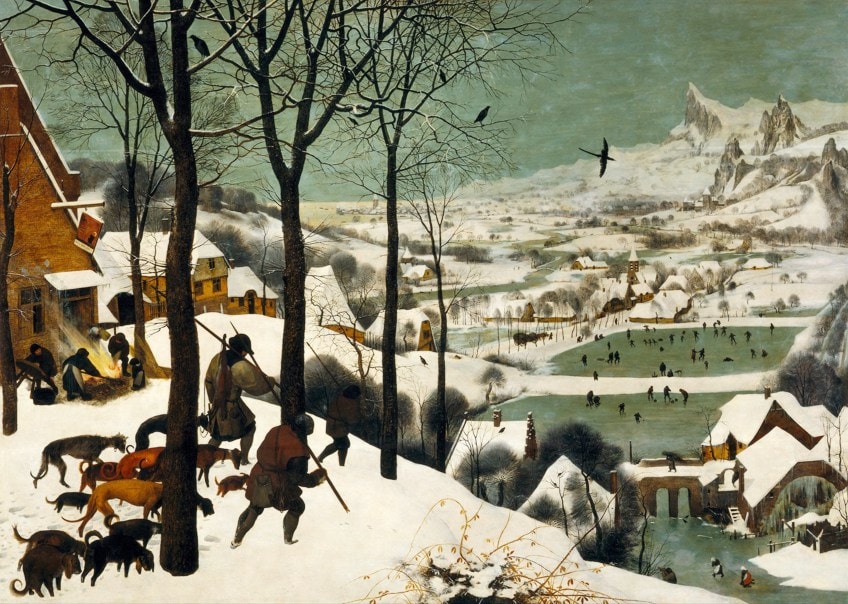
Methods and Mediums
During the Middle Ages, techniques began evolving as artists began striving for realism and the illusion of more three-dimensional paintings. Bruegel was one of the last few artists to be taught Medieval techniques, which were passed on to his master Pieter Coecke van Aelst by his master.
These included drolleries for sacred texts and “tüchlein” painting, in which loose pigment is mixed with natural glue to form paint, and this is then fixed to linen or canvas.
Bruegel was also a fan of the impasto technique, later used by Impressionists. Impasto was commonly used during the Renaissance, particularly by Venetian artists. It consists of applying paint thickly onto the canvas in order to add texture. Bruegel was also known to then carve texture into the semi-dry paint in an attempt to add further detail to his paintings.
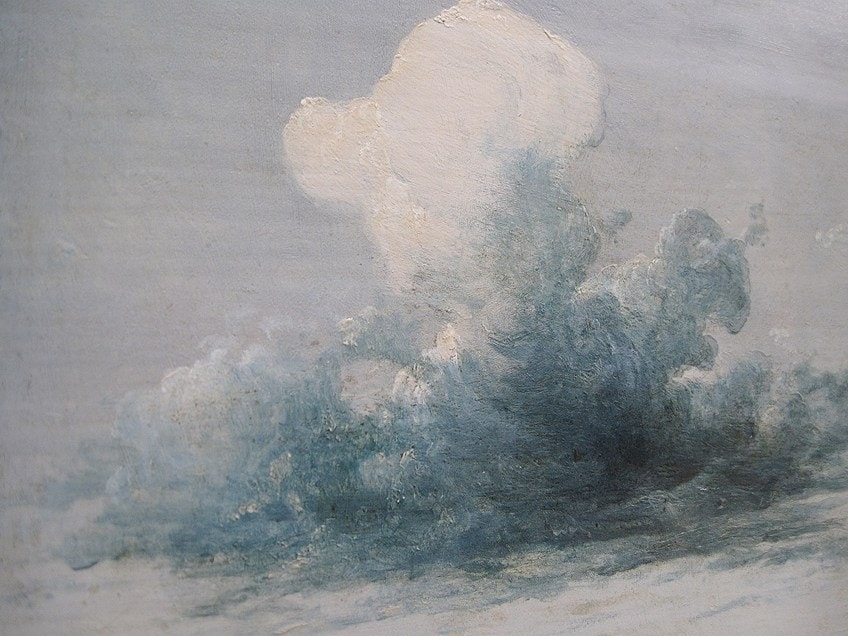
Modern Pieter Bruegel the Elder Exhibitions
Little is known about whether or not Bruegel exhibited his paintings during his lifetime. Many of his paintings are not even in existence anymore. However, what is known is that his art was desired and Flemish art collectors kept in constant supply of work. Therefore, this section will look at modern exhibitions of Bruegel’s work.
The Bruegel Exhibition (2019)
In 2019, the Kunsthistorisches Museum in Vienna, Austria held the largest ever exhibition of the work of Pieter Bruegel the Elder. The event was held to mark 450 years since the death of the legendary painter. The exhibition had been intended for the 400th anniversary of his death, however, they were unable to organize a collection of his works big enough.
However, thanks to numerous museums and private collectors around Europe lending agreeing to lend their art, the exhibition took place in 2019. Vienna was the best place to hold the exhibition as the Austrian House of Habsburg owned one of the largest private collections of Bruegel’s work.
Although many of Bruegel’s paintings did not survive until the modern day, the exhibition still had an impressive display. With almost 40 of his most famous paintings, 60 sketches, and 80 prints there was a great deal to look at. People flocked to Vienna from all over the globe to see this once-in-a-lifetime exhibition.
Pieter Bruegel the Elder Artworks
As has already been mentioned many times in this article, we do not have copies of all of the artworks Bruegel created. Thankfully, Bruegel was an artist who created prolifically and thus there are still many examples of his work. Below is a list of some of his most famous drawings and paintings.
Drawings
Many of Bruegel’s drawings were turned into prints and mass produced. For this reason, they are well-known in a number of countries. Here is a short list of some of his most famous drawings.
- Village View With Trees and a Mule (c. 1526 – 1569)
- Big Fish Eat Little Fish (1556)
- The Ass in the School (1556)
- The Painter and the Connoisseur (c. 1565)
- St James the Greater at Hermogenes (1565)
- The Calumny of Apelles (1565)
- Prudence (1559)
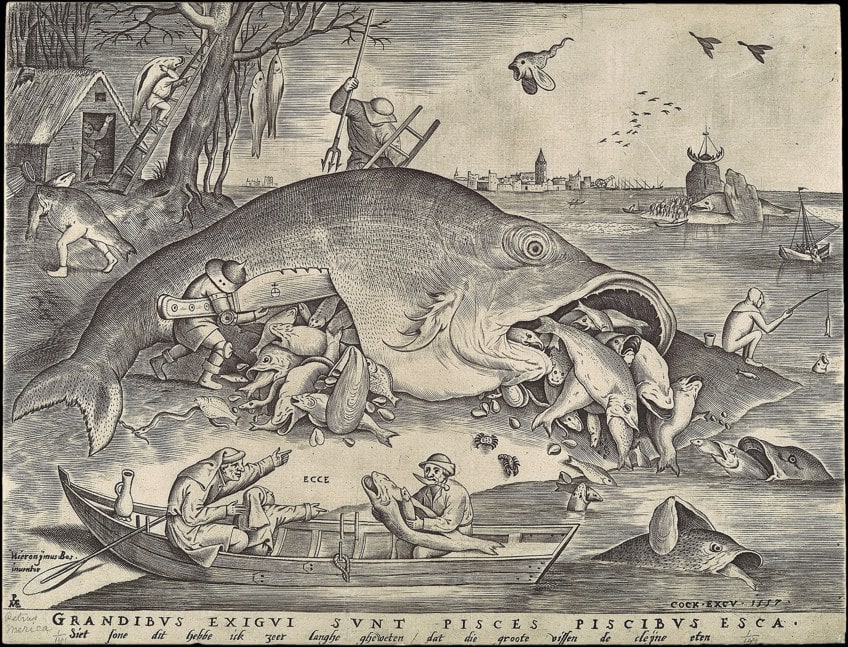
Paintings
So, what did Pieter Bruegel paint? The artist in Bruegel really came to life when he switched to painting. He began creating masterpieces, which received praise from art lovers as well as art critics. Here is a list of some of Bruegel’s most well-loved paintings.
| Title | Date | Dimensions (cm) | Medium |
| Landscape with the Fall of Icarus | c. 1558 | 112 x 73 | Oil on canvas |
| The Fight Between Carnival and Lent | 1559 | 164 x 118 | Oil on panel |
| The Netherlandish Proverbs | 1559 | 163 x 117 | Oil on wood |
| The Tower of Babel | 1563 | 155 x 114 | Oil on panel |
| The Hunters in the Snow | 1565 | 162 x 117 | Oil on wood |
| The Wedding Dance | 1566 | 183 x 145 | Oil on wood |
| The Conversion of Paul | 1567 | 156 x 108 | Oil on wood |
| The Blind Leading the Blind | 1568 | 154 x 85 | Tempera on canvas |
| The Magpie on the Gallows | 1568 | 51 x 46 | Oil on wood |
A Closer Look at Bruegel’s Paintings
Pieter Bruegel the Elder created many skillfully executed and meaningful paintings. However, the following paintings were chosen because they exhibit Bruegel’s political and religious beliefs, as well as his celebration of the peasantry.
The Fight Between Carnival and Lent (1559)
There are two theories, which guess at the inspiration behind The Fight Between Carnival and Lent (1559). Some believe that it was influenced by a print Frans Hogenberg created for Hieronymus Cock called Lent and Carnival (1558). Others say it was stimulated by the French poem La Bataille de Caresme et de Charnage, which was popular in the 1200s. It is likely that both played a part in the creation of The Fight Between Carnival and Lent.
The Fight Between Carnival and Lent is full of various layers of symbolism. On the surface we see a struggle taking place between joyful carnival attendants and solemn Lent representatives. Many countries around the world celebrate carnival, however, they do not all celebrate it at the same time.
In the Netherlands, the carnival takes place from the Sunday until the Tuesday just before Ash Wednesday. Christians celebrate Lent for 40 days following Ash Wednesday.
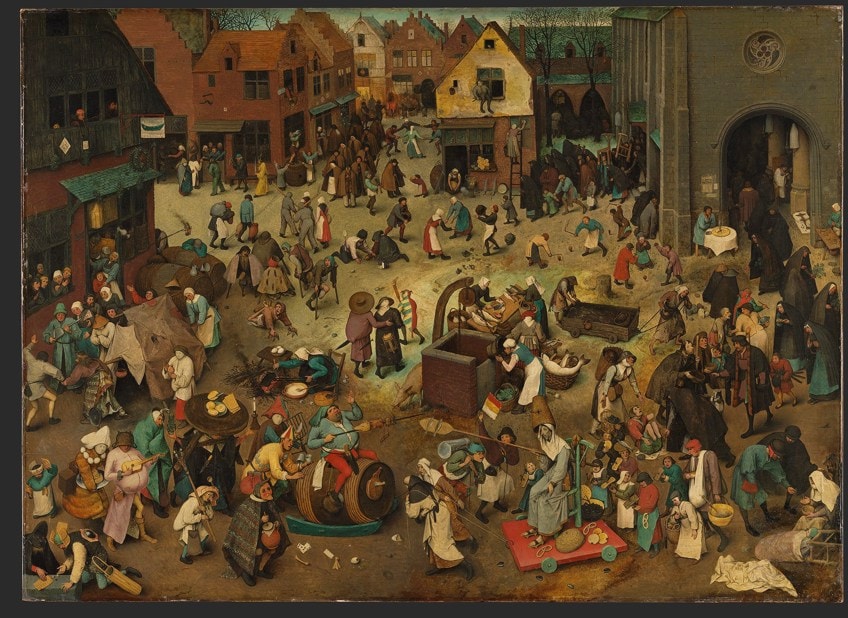
Bruegel chose these two holidays because they are in stark contrast, even though they take place within the same week. Carnival is all about celebration and pleasure. Many who celebrate it will indulge in rich food, drink too much, and even behave badly. Lent on the other hand is all about self-denial and sacrifice. In the painting we see carnival personified by a man riding a wine barrel with reckless abandon, which has a piece of meat pinned to it. A nun who has an offering of fish is representative of Lent.
The painting of almost 200 figures is divided along a diagonal, with the carnival on the left and Lent on the right. On the left, we see a tavern, which is indicative of the raptures of carnival. It is contrasted with a church on the right, in which all of the artwork is covered in the tradition of Lent.
However, it is believed that The Fight Between Carnival and Lent has a deeper meaning. A common theory is that Bruegel used the painting to make a subtle political statement. At this time, many countries in Europe including the Netherlands were experiencing a religious shift from Catholicism to Protestantism. Countries such as Spain tried to prevent this shift, which resulted in the Spanish Inquisition and later The Eight Years’ War. Bruegel used Lent to represent the staunch traditionalism of the Catholic Church and carnival to represent the reformists.
The Wedding Dance (1566)
As an artist, Bruegel liked to highlight the virtues of the peasantry. This was unheard of during the Renaissance, in which only biblical and mythological themes were thought of as appropriate subject matter. It is for this reason that Bruegel is considered to have pioneered the painting of everyday life, also known as genre painting.
During the Renaissance, if peasants were painted, it was often to ridicule or poke fun at them. Bruegel, however, painted them as a celebration of Dutch heritage and the way most people had traditionally lived.
During this time, the Netherlands was ruled by Spain and thus, it was even more important that they hold on to their traditions. He also painted the peasantry to draw attention to the everyday struggles of the poor and working class.

The Wedding Dance uses a simple yet bold color scheme of reds, blues, and greens. This is reminiscent of the colors typically used in folk art. It is also fitting that such vibrant colors are used for such a joyful occasion. The painting is composed in Bruegel’s typical manner of a chaotic cluster of figures who dance, drink, and make merry. In the center of the painting, we see the happy couple celebrating their matrimony. The bride is seen in a black wedding dress, as was typical of the time.
Finally, many have noted a still figure with a black cap watching the party from a corner. It is theorized that this voyeur is representative of the artist. He observes with wonder but is not actually part of the wedding celebrations.
Many believe that this confirms the idea that Bruegel was high-born and longed for the simple joys of peasant life.
Book Recommendations
Very little is known about Bruegel’s early life and many of his paintings are no longer in existence. However, this has not stopped people from learning as much as they can about the life and art of this iconic artist.
Below are some book recommendations for those wishing to learn more about the amazing Pieter Bruegel the Elder.
Bruegel: Master of Art (2012) by William Dello Russo
Bruegel: Master of Art was written by William Dello Russo and published by Prestel publishers in August 2012. The book revolves around the artwork of Pieter Bruegel the Elder rather than his life. It has crystal clear photographs of all of his artwork with magnifying glass-like zooms of particular details within his paintings. This is the perfect book for someone trying to study the art style of this legendary artist.
- A generously illustrated volume on the work of Pieter Bruegel
- Includes impeccably reproduced images and full-page spreads
- Also highlights the smaller details of the artist's masterpieces
Bruegel in Detail (2014) by Manfred Sellink
Bruegel in Detail was written by expert in all things Pieter Bruegel, Manfred Sellink and published in 2014 by Harry N. Abrams publishers. This hardcover provides an extensive compilation of sketches, prints, and paintings by the artist. It is organized by theme (e.g., “Landscapes”, “Daily Life”, etc.), which allows the reader to draw parallels in Bruegel’s work. Sellink also goes into detail about the impact Bruegel made on the art world.
- Reproductions of Bruegel’s best paintings, drawings, and prints
- Reveals the artist's works as never before to showcase his mastery
- Organised by theme with astonishing views of popular works of art
Bruegel (2015) by Rainer and Rose-Marie Hagen
Bruegel was written by Rainer and Rose-Marie Hagen and published by Taschen publishers in September 2015. They look at the biography of Bruegel in as much detail as is available, as well as discuss why Bruegel became such an influential artist. Finally, the book also contains photographs of Bruegel’s work accompanied by analyses of his creations.
Pieter Bruegel the Elder was an artist who created paintings far ahead of his time. Therefore, it is unusual that he had such success as an artist during his lifetime. This is likely due to the fact that although his works were unorthodox, he displayed a talent and wit in his paintings that was undeniable. In the modern era, he is still revered and is praised as a formative figure in genre painting.
Frequently Asked Questions
What Did Pieter Bruegel Paint?
Unfortunately, many of Pieter Bruegel’s artworks did not withstand the test of time. However, those that survive have been praised by art lovers and art critics alike. His undeniable talent can be witnessed in famous paintings such as Landscape with the Fall of Icarus (c. 1558), The Fight Between Carnival and Lent (1559), and The Tower of Babel (1563).
What Northern Renaissance Characteristics Did Pieter Bruegel the Elder Incorporate in His Paintings?
Pieter Bruegel the Elder often created paintings that were offbeat and unique during their time. For this reason, many believe him to be a pioneer in the fields of landscape and genre painting. However, although his artworks were original, he still utilized many common characteristics of the Northern Renaissance art style. Traits such as a penchant for including many intricate details in his paintings can be seen in the works of other iconic Dutch painters such as Hieronymus Bosch. Bruegel also created paintings containing religious satire, which was also typical of the Northern Renaissance art style.

Emma completed her Bachelor’s Degree in International Studies at the University of Stellenbosch. She majored in French, Political Science, and History. She graduated cum laude with a Postgraduate Diploma in Intercultural Communication. However, with all of these diverse interests, she became confused about what occupation to pursue. While exploring career options Emma interned at a nonprofit organization as a social media manager and content creator. This confirmed what she had always known deep down, that writing was her true passion.
Growing up, Emma was exposed to the world of art at an early age thanks to her artist father. As she grew older her interests in art and history collided and she spent hours pouring over artists’ biographies and books about art movements. Primitivism, Art Nouveau, and Surrealism are some of her favorite art movements. By joining the Art in Context team, she has set foot on a career path that has allowed her to explore all of her interests in a creative and dynamic way.
Learn more about the Art in Context Team.
Cite this Article
Emma, Littleton, “Pieter Bruegel the Elder – The Northern Renaissance Artist, Bruegel.” Art in Context. August 15, 2022. URL: https://artincontext.org/pieter-bruegel-the-elder/
Littleton, E. (2022, 15 August). Pieter Bruegel the Elder – The Northern Renaissance Artist, Bruegel. Art in Context. https://artincontext.org/pieter-bruegel-the-elder/
Littleton, Emma. “Pieter Bruegel the Elder – The Northern Renaissance Artist, Bruegel.” Art in Context, August 15, 2022. https://artincontext.org/pieter-bruegel-the-elder/.






